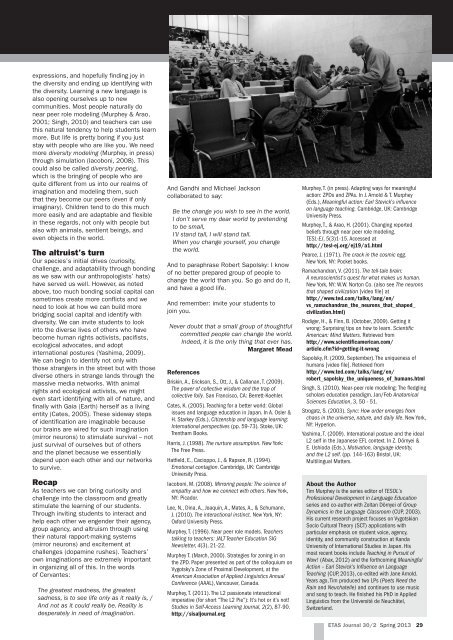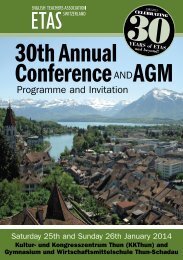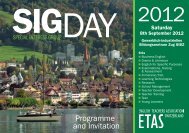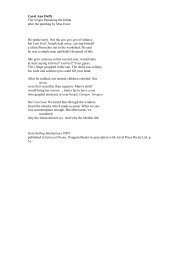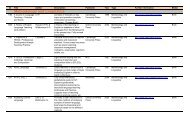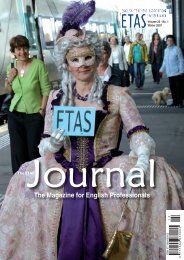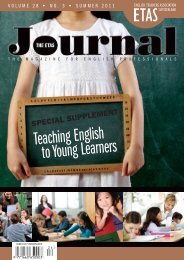Spring Journal 2013 - English Teachers Association of Switzerland
Spring Journal 2013 - English Teachers Association of Switzerland
Spring Journal 2013 - English Teachers Association of Switzerland
You also want an ePaper? Increase the reach of your titles
YUMPU automatically turns print PDFs into web optimized ePapers that Google loves.
expressions, and hopefully finding joy inthe diversity and ending up identifying withthe diversity. Learning a new language isalso opening ourselves up to newcommunities. Most people naturally donear peer role modeling (Murphey & Arao,2001; Singh, 2010) and teachers can usethis natural tendency to help students learnmore. But life is pretty boring if you juststay with people who are like you. We needmore diversity modeling (Murphey, in press)through simulation (Iacoboni, 2008). Thiscould also be called diversity peering,which is the bringing <strong>of</strong> people who arequite different from us into our realms <strong>of</strong>imagination and modeling them, suchthat they become our peers (even if onlyimaginary). Children tend to do this muchmore easily and are adaptable and flexiblein these regards, not only with people butalso with animals, sentient beings, andeven objects in the world.The altruist’s turnOur species’s initial drives (curiosity,challenge, and adaptability through bondingas we saw with our anthropologists’ hats)have served us well. However, as notedabove, too much bonding social capital cansometimes create more conflicts and weneed to look at how we can build morebridging social capital and identify withdiversity. We can invite students to lookinto the diverse lives <strong>of</strong> others who havebecome human rights activists, pacifists,ecological advocates, and adoptinternational postures (Yashima, 2009).We can begin to identify not only withthose strangers in the street but with thosediverse others in strange lands through themassive media networks. With animalrights and ecological activists, we mighteven start identifying with all <strong>of</strong> nature, andfinally with Gaia (Earth) herself as a livingentity (Cates, 2005). These sideway steps<strong>of</strong> identification are imaginable becauseour brains are wired for such imagination(mirror neurons) to stimulate survival – notjust survival <strong>of</strong> ourselves but <strong>of</strong> othersand the planet because we essentiallydepend upon each other and our networksto survive.RecapAs teachers we can bring curiosity andchallenge into the classroom and greatlystimulate the learning <strong>of</strong> our students.Through inviting students to interact andhelp each other we engender their agency,group agency, and altruism through usingtheir natural rapport-making systems(mirror neurons) and excitement atchallenges (dopamine rushes). <strong>Teachers</strong>’own imaginations are extremely importantin organizing all <strong>of</strong> this. In the words<strong>of</strong> Cervantes:The greatest madness, the greatestsadness, is to see life only as it really is, /And not as it could really be. Reality isdesperately in need <strong>of</strong> imagination.And Gandhi and Michael Jacksoncollaborated to say:Be the change you wish to see in the world.I don’t serve my dear world by pretendingto be small,I’ll stand tall, I will stand tall.When you change yourself, you changethe world.And to paraphrase Robert Sapolsky: I know<strong>of</strong> no better prepared group <strong>of</strong> people tochange the world than you. So go and do it,and have a good life.And remember: invite your students tojoin you.Never doubt that a small group <strong>of</strong> thoughtfulcommitted people can change the world.Indeed, it is the only thing that ever has.Margaret MeadReferencesBriskin, A., Erickson, S., Ott, J., & Callanan, T. (2009).The power <strong>of</strong> collective wisdom and the trap <strong>of</strong>collective folly. San Francisco, CA: Berrett-Koehler.Cates, K. (2005). Teaching for a better world: Globalissues and language education in Japan. In A. Osler &H. Starkey (Eds.), Citizenship and language learning:International perspectives (pp. 59-73). Stoke, UK:Trentham Books.Harris, J. (1998). The nurture assumption. New York:The Free Press.Hatfield, E., Cacioppo, J., & Rapson, R. (1994).Emotional contagion. Cambridge, UK: CambridgeUniversity Press.Iacoboni, M. (2008). Mirroring people: The science <strong>of</strong>empathy and how we connect with others. New York,NY: Picador.Lee, N., Dina, A., Joaquin, A., Mates, A., & Schumann,J. (2010). The interactional instinct. New York, NY:Oxford University Press.Murphey, T. (1996). Near peer role models. <strong>Teachers</strong>talking to teachers: JALT Teacher Education SIGNewsletter, 4(3), 21-22.Murphey T. (March, 2000). Strategies for zoning in onthe ZPD. Paper presented as part <strong>of</strong> the colloquium onVygotsky’s Zone <strong>of</strong> Proximal Development, at theAmerican <strong>Association</strong> <strong>of</strong> Applied Linguistics AnnualConference (AAAL), Vancouver, Canada.Murphey, T. (2011). The L2 passionate interactionalimperative (for short “The L2 Pie”): It’s hot or it’s not!Studies in Self-Access Learning <strong>Journal</strong>, 2(2), 87-90.http://sisaljournal.orgMurphey, T. (in press). Adapting ways for meaningfulaction: ZPDs and ZPAs. In J. Arnold & T. Murphey(Eds.), Meaningful action: Earl Stevick’s influenceon language teaching. Cambridge, UK: CambridgeUniversity Press.Murphey, T., & Arao, H. (2001). Changing reportedbeliefs through near peer role modeling.TESL-EJ, 5(3)1-15. Accessed athttp://tesl-ej.org/ej19/a1.htmlPearce, J. (1971). The crack in the cosmic egg.New York, NY: Pocket books.Ramachandran, V. (2011). The tell-tale brain:A neuroscientist’s quest for what makes us human.New York, NY: W.W. Norton Co. (also see The neuronsthat shaped civilization [video file] athttp://www.ted.com/talks/lang/en/vs_ramachandran_the_neurons_that_shaped_civilization.html)Rodiger, H., & Finn, B. (October, 2009). Getting itwrong: Surprising tips on how to learn. ScientificAmerican: Mind Matters. Retrieved fromhttp://www.scientificamerican.com/article.cfm?id=getting-it-wrongSapolsky, R. (2009, September). The uniqueness <strong>of</strong>humans [video file]. Retrieved fromhttp://www.ted.com/talks/lang/en/robert_sapolsky_the_uniqueness_<strong>of</strong>_humans.htmlSingh, S. (2010). Near-peer role modeling: The fledglingscholars education paradigm. Jan/Feb AnatomicalSciences Education, 3, 50 - 51.Strogatz, S. (2003). Sync: How order emerges fromchaos in the universe, nature, and daily life. New York,NY: Hyperion.Yashima, T. (2009). International posture and the idealL2 self in the Japanese EFL context. In Z. Dörnyei &E. Ushioda (Eds.), Motivation, language identity,and the L2 self. (pp. 144-163) Bristol, UK:Multilingual Matters.About the AuthorTim Murphey is the series editor <strong>of</strong> TESOL’sPr<strong>of</strong>essional Development in Language Educationseries and co-author with Zoltan Dörnyei <strong>of</strong> GroupDynamics in the Language Classroom (CUP, 2003).His current research project focuses on VygotskianSocio Cultural Theory (SCT) applications withparticular emphasis on student voice, agency,identity, and community construction at KandaUniversity <strong>of</strong> International Studies in Japan. Hismost recent books include Teaching in Pursuit <strong>of</strong>Wow! (Abax, 2012) and the forthcoming MeaningfulAction – Earl Stevick’s Influence on LanguageTeaching (CUP, <strong>2013</strong>), co-edited with Jane Arnold.Years ago, Tim produced two LPs (Poets Need theRain and Neuchatelle) and continues to use musicand song to teach. He finished his PhD in AppliedLinguistics from the Université de Neuchâtel,<strong>Switzerland</strong>.ETAS <strong>Journal</strong> 30/2 <strong>Spring</strong> <strong>2013</strong> 29


